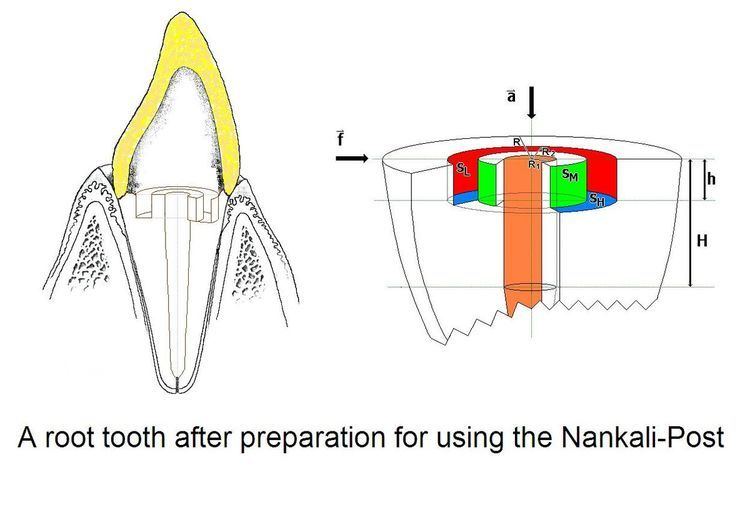 | ||
The Nankali post system is a post and cores prosthesis, which is used in prosthodontology and dental restoration. This post and core consists of a single smooth or serrated post and core which has an additional circle ring (counter sink) around it.
Contents
- General indications
- Contraindication
- Advantages
- Disadvantages
- Fractured teeth
- Treatment
- Bur
- History
- References
The additional single-circle ring increases the contact surface area between the core and involved part of tooth significantly. Increased contact surface area decreases the pressure between the two objects (remaining part of the tooth and post-core) and is followed by a declining in the number of failures in treatments.
General indications
The main indications are:
Contraindication
Advantages
The majority of the advantages are the same as other post and core systems; however, there are some points which make it different such as:
The post can be used for treating both single or multi-rooted teeth and also in combination with other types of prosthetics.
The insertion ring increases the level of fixation, distribute equally mastication pressure and provide appropriate condition for prosthetics.
It is also recommended for using bridges, crown or other types of dental prosthetics, if a post core is required for treatment .
Disadvantages
The disadvantages are as follows:
Fractured teeth
The post is suitable for those types of fractures in which the fracture line passes apical to the crown. In the first stage it is necessary to examine the patient in order to be sure that there is no sign of any fracture in the mandible or maxilla, then analyse the possibility of treatment of the fractured tooth canal. In addition, the condition of the tooth for using the bur requires to be checked as well.
In the situation of having suitable condition, after treatment and preparation of the root canal, it is possible to use this type of post-core. The root canal requires a two different sizes preparation. In this case the post and core are separate and they will be joined together in the second stage. By rotating the serrated post that is fixed to the special core the system keeps the broken parts together.
Four year observation of patients treated by this method, confirmed a '100% result' without any 'complication' in the National Medical University at the Orthopedic and Implant Stomatology Department; however, before using this type of treatment the conditions have to be analyzed carefully.
Treatment
The essential requirement for using this post and core is its bur, which is manufactured in different sizes to produce an additional circle ring around the canal of a tooth.
The same as traditional treatment method by any post and core, the root canal is prepared using parallel-side twist drill after treating and filling canal by an inert gutta percha or similar material. Then root canal needs to be prepared with the maximum possible depth for the second stage. However, it has to be noticed that the minimum essential requirement of canal is one third of its length, which is necessary in order to fix the core.
In the next stage, using the specific bur, dentist prepares an additional circle ring around the tooth canal. The post and core can then be constructed either by a direct technique or by an indirect technique. In the direct technique a pattern is fabricated in the mouth using either inlay wax or a burn out resin (e.g. Duralay) which is then sent to the laboratory for casting. For the direct technique, which is more widely used, an impression is taken using a matched plastic impression post placed in the prepared post hole.
For the post-core, it is possible to use different material such as metals or the high strong fibres which is used in dental laboratories.
Bur
The designed bur for treating teeth is a bur consisting of a central guider and two symmetrical cutter to produce a single-circle ring. This bur is used after preparation of the root canal similar to other posts.
The two main advantages of this bore are speed in preparation root canals and its accuracy. The bur is designed in different sizes, which make it available for using in treatment of various teeth. The depth of the prepared ring is in direct proportion with the size of bore.
One of the major problems of using this post system is its bur, which means without having the bur it is impossible to use it.
History
The Nankali-post was designed in 1997 in the National Medical University at the Orthopedic and Implant Stomatology Department by Dr. Ali Nankali, which (October 1999) verified by Scientific Board of Bogomolets National Medical University and international patent organization (УДК; 616.314-76-77:616.314.11-74:678.029.46:612.311) in Kiev/Ukraine.
Initially it was presented at the 54Th Medical Science Conference of Students & Young Scientists in 1999, that was organized by Ukraine Health Ministry and National Medical University known as O.O. Bogomolets and Society Science Students known as O.O. Kisilia. The result of presentation was published in "Young Scientists and Students / Scientific Medical Seminar in 1999".
In 1999 it was requested for the patent (УДК; 616.314-76-77:616.314.11-74:678.029.46:612.311)and became a part of research of the Orthopedic and Implant Stomatology Department of the National Medical University. This new modified post-core was under study till 2004 and then attested by the Dental Scientific Board of Ukraine.
During the four years of careful observation (2000-2004 / National Medical University in Kiev), the number of reported complication from patient, whom were treated with the Nankali-post was none.
Initially the bur and cast post-core were manufactured in the laboratory of the Orthopedic and Implant Stomatology Department of the National Medical University (O.O.Bogomolets) in Kiev.
